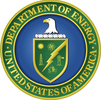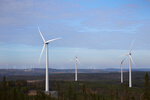News Release from U.S. Department of Energy (DOE)
Wind Industry Profile of
DOE Finds Record Production and Job Growth in U.S. Wind Power Sector
The U.S. Department of Energy (DOE) today released three reports showing that wind power remains one of America’s fastest growing energy sources and a generator of high-quality jobs. Wind power accounted for 32% of U.S. energy capacity growth in 2021, employs 120,000 Americans, and now provides enough energy to power 40 million American homes. The 2021 wind market reports show that the domestic expansion of wind power is proving to be an essential source of clean, cheap energy generation that supports President Biden’s goals of reaching 100% clean electricity by 2035 and a net zero economy by 2050.
“These reports show U.S. wind energy deployment and generating capacity are booming—delivering cheap, reliable, and clean energy to power even more American homes and businesses,” said U.S. Secretary of Energy Jennifer M. Granholm. “The rapid technological and industrial advances in the domestic wind sector are creating new jobs for the clean energy workforce and assuring wind power’s critical role in achieving President Biden’s climate and decarbonization goals.”
Technology advancement, state-level policies, and the federal production tax credit (PTC) have fueled the wind sector’s growth in recent years, but the PTC for wind expired at the end of 2021, creating market uncertainty. The passage of the Inflation Reduction Act, which invests billions of dollars in wind energy by extending the PTC for at least 10 years and encouraging investment in American clean energy manufacturing, gives long-term certainty to the wind industry and is likely to fuel the sector’s rapid growth in the years to come.
The Inflation Reduction Act includes long-term extensions of critical tax incentives supporting the deployment of all three wind applications – land-based, offshore and distributed – and new programs to support the siting and construction of high-voltage transmission lines, which will be important for both land-based and offshore wind. Also included are new production-based tax credits for domestic manufacturing and supply of wind components and equipment, which will provide strong incentives to onshore key supply chains of wind turbines and related components.
The 2022 edition of the Land-Based Wind Market Report, prepared by DOE’s Lawrence Berkeley National Laboratory, detailed 13,413 MW of new utility-scale land-based wind generation capacity added in 2021 -- the equivalent of powering more than 4 million American homes and representing $20 billion investment in new wind power investment.Key findings from the report include:
- Wind energy provided more than 9% of total electricity nationwide, more than 50% in Iowa and South Dakota and 30% in Kansas, Oklahoma, and North Dakota.
- Twenty-two states installed new utility-scale land-based wind turbines in 2021. Texas installed the most capacity, with 3,343 MW. Other leading states include Oklahoma, New Mexico, and Kansas, which all added more than 1,000 MW of capacity in 2021.
- Wind turbines continue to grow in size and power, leading to more cheap clean energy production. The average capacity of newly installed wind turbines grew 9% from 2020 to 2021, to 3 MW.
- For wind projects built in 2021, the researchers estimated public health benefits, climate benefits, and value to the grid are worth more than triple the cost of generating electricity from wind energy.
The 2022 edition of the Offshore Wind Market Report, prepared by DOE’s National Renewable Energy Laboratory, found that the capacity of U.S. offshore wind energy projects being developed and currently operating increased 14% from the previous year to 40,083 MW. This includes two operating projects totaling 42 MW and 38 projects under development totaling 35,509 MW, enough to potentially power about 13 million American homes. The report also found:
- The Biden-Harris administration significantly expanded offshore wind development in new areas of the country, including six new lease areas auctioned in the New York Bight and two new lease areas auctioned in Long Bay, off the coast of the Carolinas. There are also plans to lease new areas in California, the Gulf of Mexico, the Central Atlantic, Oregon, and the Gulf of Maine.
- As of May 2022, 24 offshore wind projects have signed contracts to sell their power, totaling 17,579 MW.
- New York had the highest energy capacity in the U.S. offshore wind energy pipeline, with 11,162 MW, followed by Massachusetts (8,553 MW), New Jersey (4,758 MW), and California (4,532 MW).
- Bureau of Ocean Energy Management (BOEM) is planning areas for future leasing that could potentially provide another 4,532 MW of power.
- The global capacity for proposed floating offshore wind energy—turbines mounted to a floating foundation or substructure—more than doubled in 2021 from 26,529 MW to 60,746 MW. Deployment of this technology is likely to continue gaining momentum as the industry works to lower costs through innovation and global market growth.
The 2022 edition of the Distributed Wind Market Report, prepared by DOE’s Pacific Northwest National Laboratory, notes that 1,751 distributed wind turbines were added across 15 states. The turbines, which serve on-site energy demand or support operation of local electricity distribution networks, total 11.7MW of new capacity and represent $41 million in new investment in 2021.
- Cumulative U.S. distributed wind capacity stands at 1,075 MW from the more than 89,000 wind turbines across all 50 states, the District of Columbia, Puerto Rico, the U.S. Virgin Islands, and Guam.
- Rhode Island, Kansas, and Minnesota led the United States in distributed wind capacity additions in 2021, with each state completing a large-scale distributed wind project.
- For small wind capacity additions, defined as turbines up to 100 kilowatts in size, Minnesota led the nation in 2021. This is largely attributed to a push to sell small wind capacity to agricultural markets, and a decline of small wind installations in New York following the discontinuation of its state incentive program.
The three market reports, including supporting blogs, videos, and infographics, are available at?energy.gov/windreport.
Learn more about the Wind Energy Technologies Office in DOE’s Office of Energy Efficiency and Renewable Energy.
- Source:
- US Department of Energy
- Author:
- Press Office
- Link:
- www.energy.gov/...
- Keywords:
- USA, Department of Energy, DOE, wind power, sector, jobs, growth, deployment, clean, workforce, renewable energy, booming, production


























